Since Open AI launched ChatGPT, AI models have transformed our research approach, content creation, and productivity. AI can be used to create music, video, images, text, and even interact like humans.
I tested some of the most innovative AI productivity tools on the market, and I am excited to share my insights on the top 28 outstanding tools.
Our comprehensive testing procedure for these tools involved real-world scenarios to gauge how they integrate with daily workflows, their ease of use, and the value they add to a typical workday.
Generative AI has catapulted productivity tools’ capabilities, enabling them to autonomously generate written content, design graphics, and even suggest decision-making strategies. My insights reveal AI writing assistants and personalized recommendation engines as the vanguards of this leap.
Editors Pick: Best AI Tools
My favorite AI tools are Jasper, Koala, RenderForest, and Grammarly for creative tasks, TrendSpider for investing, and Trello and ChatGPT for productivity. Each service saves me a lot of time in my day.
The Best AI Tools Per Category
When examining AI productivity tools, I focus on those that enhance efficiency in various categories, such as content creation, design, meetings, and task management. The tools covered are distributed among numerous facets of productivity:
- Content Creation: Generate compelling blog posts, articles, or novels with Jasper, Koala, CopyAI, AnyWord, or NovelAI.
- Grammar, Spelling, & Rephrasing: Perfect your writing with Grammarly, QuillBot or ProWritingAid.
- AI Investing Bots: Use AI to spot market trends and patterns and provide automated trading signals with TrendSpider, Trade Ideas, or Tickeron.
- AI Video & Image Generation: Craft mindblowing videos and images with Pictory, RenderForest, Klap, Canva, DALL-E, MidJourney, Runway, StabilityAI, or DeScript.
- Team Collaboration: Use AI to streamline meetings, workflow, and communications with Asana, Trello, Slack, and Notion AI.
- Project & Task Management: Streamline complex projects by efficiently organizing tasks with Zapier, Mem, Tome, or OtterAI.
- ChatBots & Research: AI-driven tools to provide detailed insight, turning raw data into actionable knowledge with ChatGPT and CharachterAI.
AI Written Content Creation
AI tools have revolutionized content creation by offering highly efficient solutions for drafting and refining text. With the advent of AI, tasks like generating blog posts, crafting marketing copy, and even penning entire books have become more accessible.
Many of these tools integrate with existing services and provide capabilities ranging from writing assistance to automating ideation processes.
1. Jasper AI for Content Creation & Marketing
Jasper.ai is a versatile writing assistant that can generate high-quality content at scale. Whether it’s social media posts or detailed marketing strategies, Jasper’s AI adapts to specific tones and even learns your writing style.
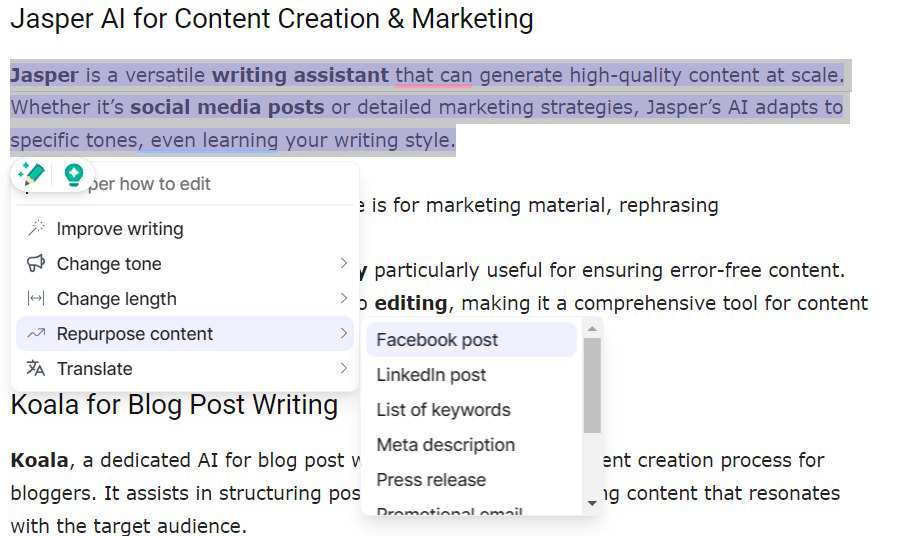
I am a paying user of Jasper and use it for marketing material, rephrasing, and repurposing content for Twitter, LinkedIn, Pinterest, and Reddit posts.
I find its integration with Grammarly particularly useful for ensuring error-free content. Jasper’s proficiency extends into editing, making it a comprehensive tool for content creators.
2. Koala for Blog Post Writing
Koala, a dedicated AI for blog post writing, simplifies the content creation process. It assists in structuring posts and generating engaging content that resonates with the target audience.
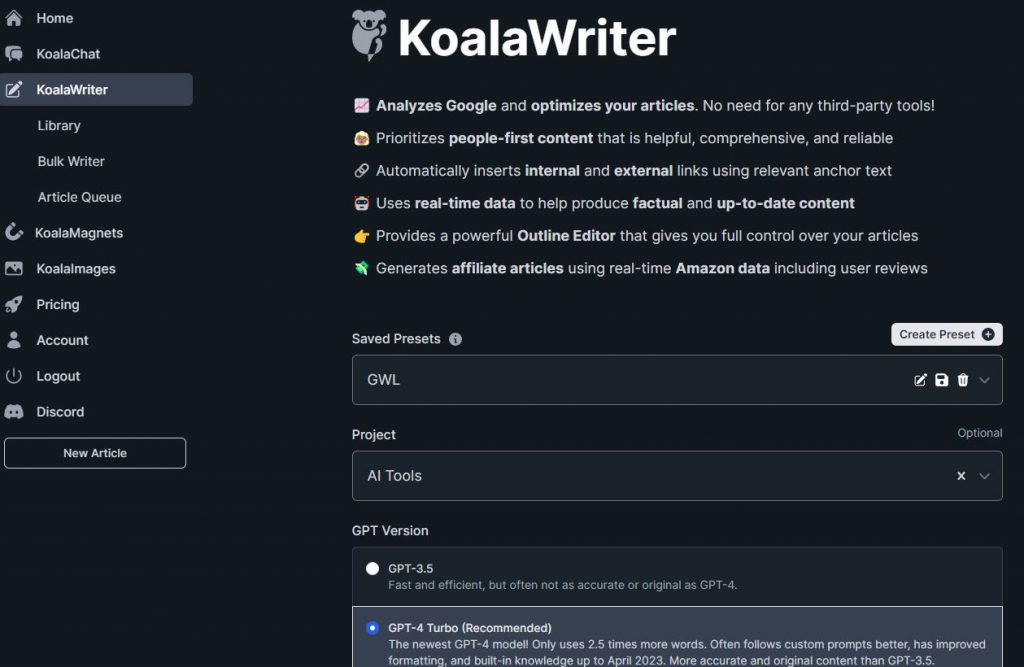
Using Koala, I noticed a significant improvement in the speed of my writing process, which allows more time for creativity. As with all article writing tools, however, they need significant editing afterward because they do not know your opinion.
Koala integrates with GPT4-Turbo, allows users to search the Internet in real-time, and provides academic citations and research.
3. Copy.AI for Automated Copywriting
Copy.AI excels at delivering high-quality copy for various marketing needs. Automating tasks dramatically reduces the time I spend crafting messages for different platforms.
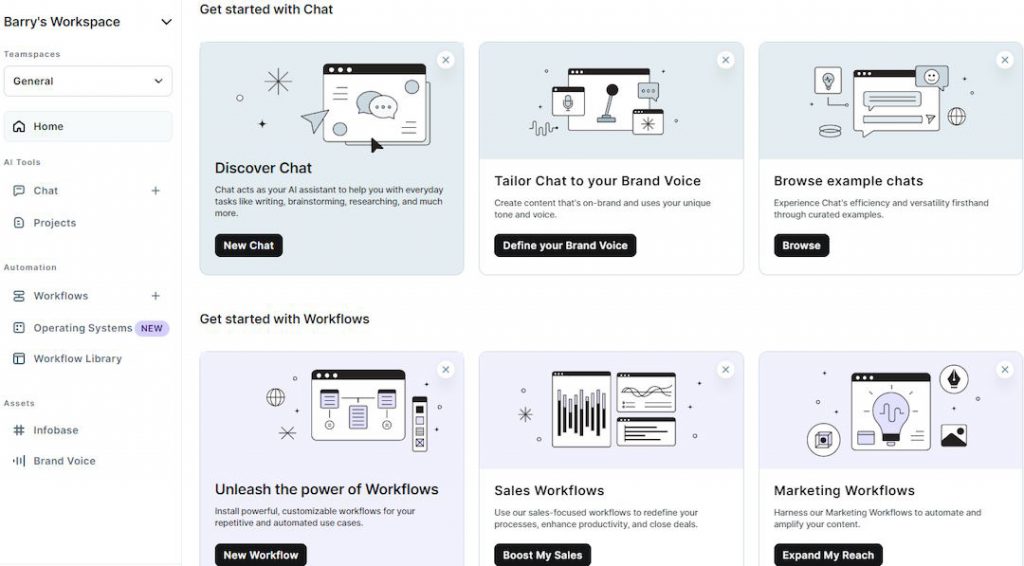
Whether it’s product descriptions or email marketing campaigns, Copy.AI provides creative ideas that align with brand messaging. It also includes sales and marketing workflows and interactive chatbots.
4. Anyword for Business Marketing
As a tool that specializes in marketing language, Anyword predicts performance to optimize copy for different audiences.
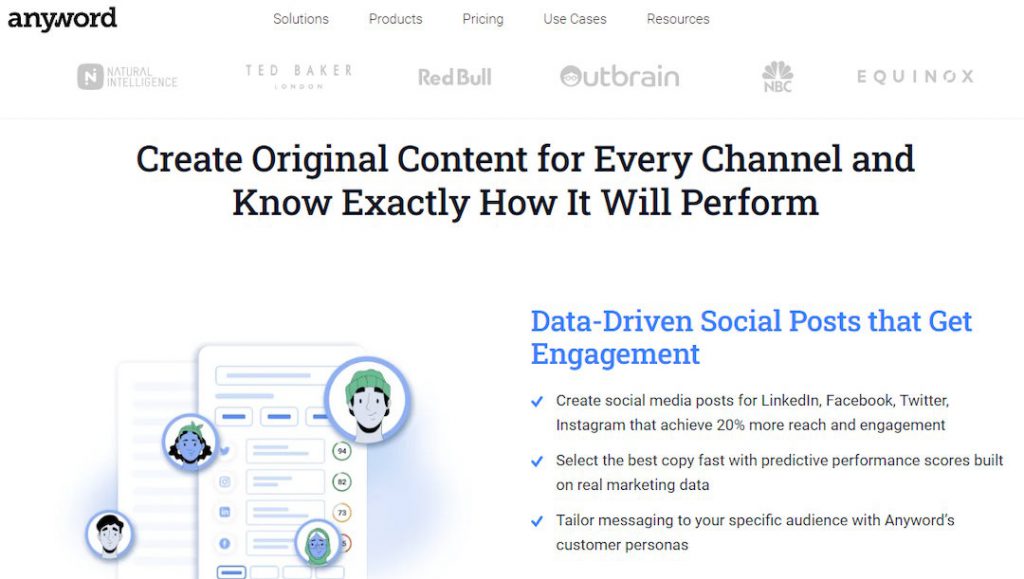
Targeted primarily at enterprise marketing teams, Anyword has AI-powered analysis that shows how to boost engagement by tailoring messages across platforms and leveraging data-driven insights to inform content strategy.
5. NovelAI for Book Writing
For aspiring or seasoned authors, NovelAI offers a suite of book-writing tools that assist in weaving compelling narratives. NovelAI helps in crafting detailed storylines and character development, making the daunting task of writing a book less overwhelming.
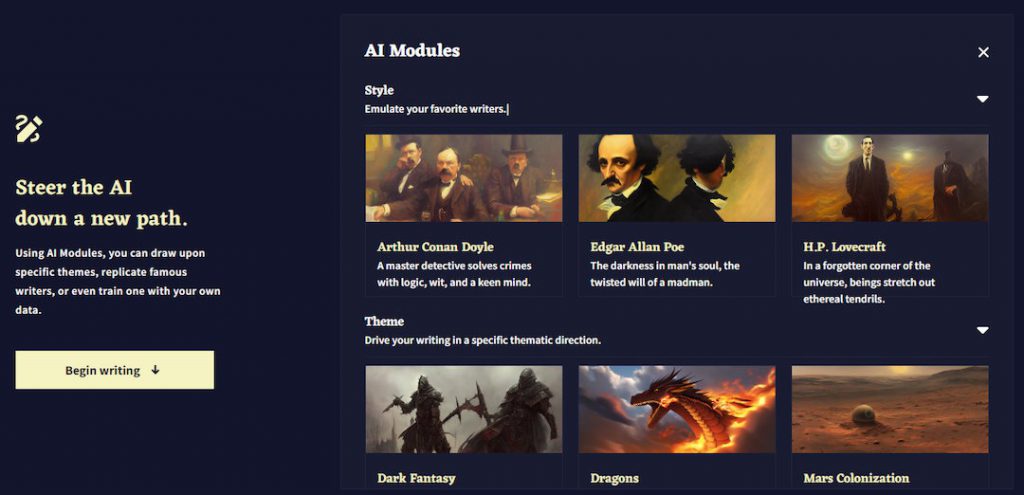
Furthermore, its intelligent algorithms suggest plot advancements, enhancing creativity. NovelAI also has author emulation bots to mimic the writing styles of famous authors, providing inspiration and guidance.
With NovelAI, writers can focus on their creativity while leaving the technical aspects to AI, resulting in a more efficient and engaging writing process. Whether working on your first novel or looking to improve your craft, NovelAI is the perfect companion for any writer.
Grammar, Spelling & Rephrasing
In my experience, leveraging AI tools for grammar, spelling, and rephrasing can significantly enhance the quality of writing. These tools provide real-time assistance to ensure clarity and correctness.
1. Grammarly for Writing Assistance
I have been a premium subscriber to Grammarly for three years and love it. I use it on all my written content to ensure perfect grammar and spelling. It even detects how engaging the content is and how I deliver the messages in the text.
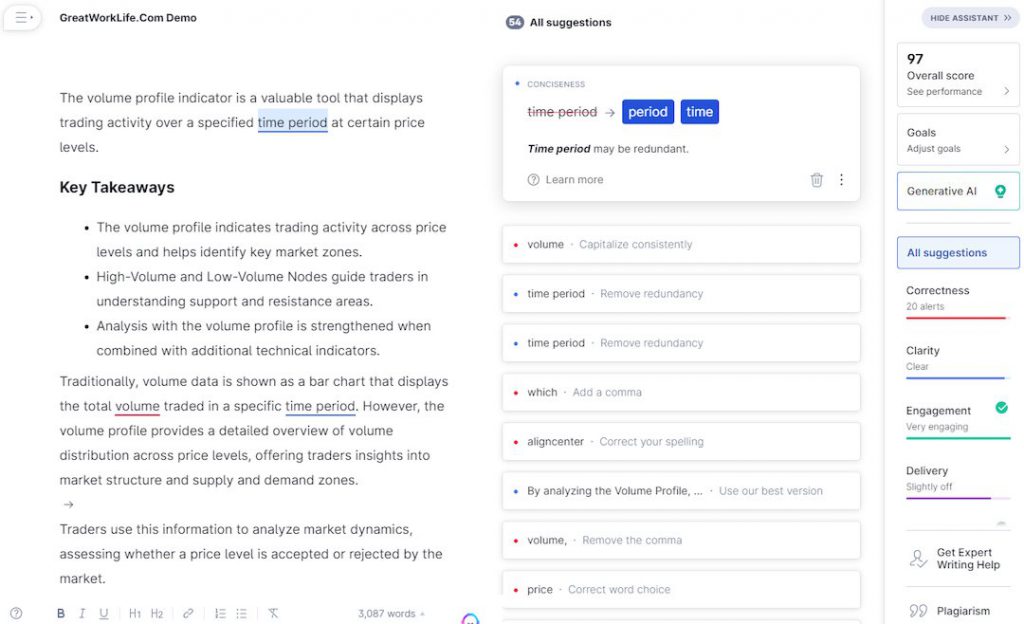
Grammarly is my go-to tool for grammar and spelling checks; Grammarly proofed this article. It seamlessly integrates with Chrome, Firefox, and Safari with browser plugins. Additionally, there are add-ons for Windows, MacOS, iOS, Android, and Microsoft Office. You can try Grammarly for free, but the premium subscription unlocks more advanced features.
- Real-time Grammar Checking: Detects complex grammar errors.
- Spelling Corrections: Identifies and corrects misspelled words.
- Tone Detection: Analyze the tone of the writing.
- Plagiarism Detection: A lightning-fast detection system.
One of the best things about Grammarly is that it not only catches basic grammar and spelling mistakes but also provides suggestions for sentence structure, vocabulary, and writing style. It explains each correction, allowing you to learn from mistakes and improve your writing skills.
2. QuillBot for Paraphrasing
QuillBot is a direct competitor to Grammarly. It stands out for its paraphrasing capabilities and citation generator, which can be handy if you are a journalist or technical writer.
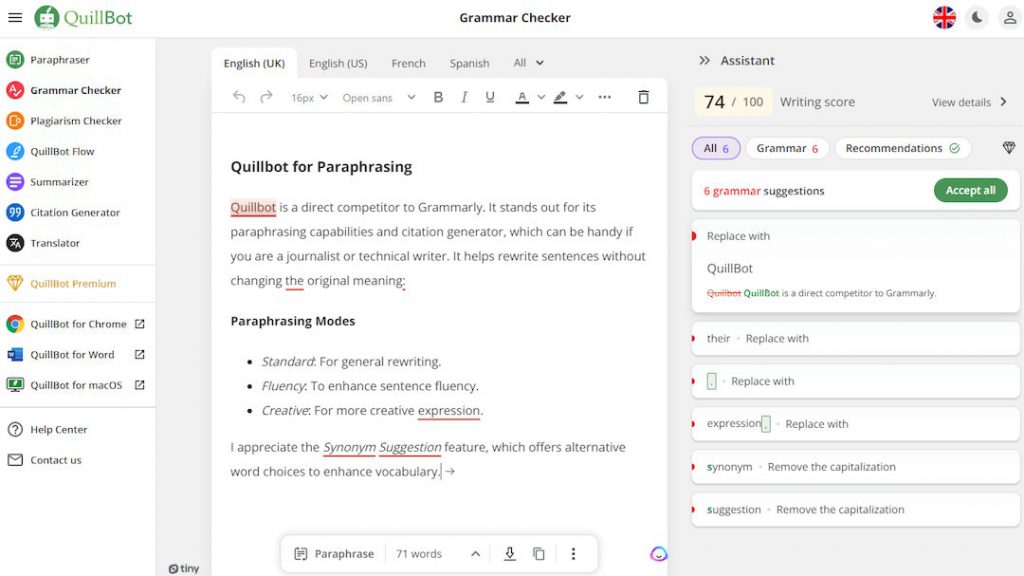
It helps rewrite sentences without changing the original meaning:
Paraphrasing Modes
- Standard: For general rewriting.
- Fluency: To enhance sentence fluency.
- Creative: For more creative expression.
I appreciate the Synonym Suggestion feature, which offers alternative word choices to enhance vocabulary. QuillBot also has Chrome, Word, and macOS plugins to enable improved workflows.
3. ProWritingAid for Accurate Writing
ProWritingAid is comprehensive, focusing both on correctness and style. It offers grammar and spelling checks, style suggestions, and readability analysis. One unique feature is the Word Explorer, which provides thesaurus entries for selected words.
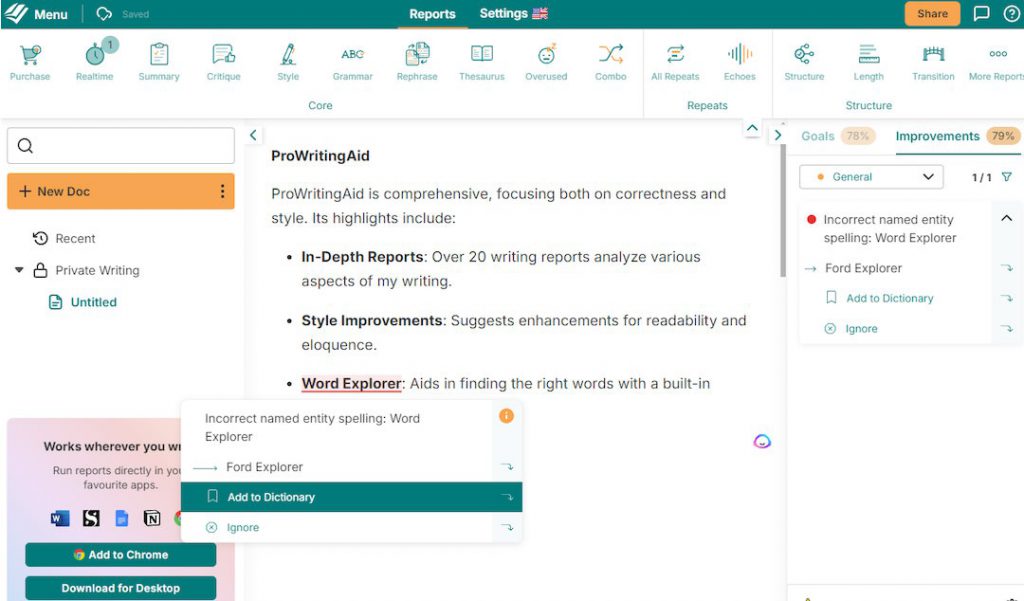
ProWritingAid offers integrations with Google Docs, Microsoft Word, and Scrivener to make editing even more convenient. It also has a desktop app for offline use.
ProWritingAid’s focus on correctness and style can be a valuable tool for writers of all levels looking to improve their writing skills.
Its highlights include:
- In-Depth Reports: Over 20 writing reports analyze various aspects of my writing.
- Style Improvements: Suggest enhancements for readability and eloquence.
- Word Explorer: Aids in finding the right words with a built-in thesaurus.
What makes ProWritingAid unique is its writing style checks and critique engine, which are tailored to your writing genre. Though not as established and slick as Grammarly or Quillbot, ProWritingAid is worth trying if you are a creative writer.
AI Investing
In my experience, AI investing tools like TrendSpider, Trade Ideas, and Tickeron have significantly changed the trading landscape. They offer capabilities ranging from automated analysis to backtesting, which can be invaluable for traders looking to streamline their investment process.
1. TrendSpider for Smart Trading
TrendSpider is a tool I’ve found particularly useful for technical analysis. It employs AI-driven chart pattern recognition and automated trendline detection, saving me a lot of time. In the image below, you can see the AI finds solution with a plain text request.
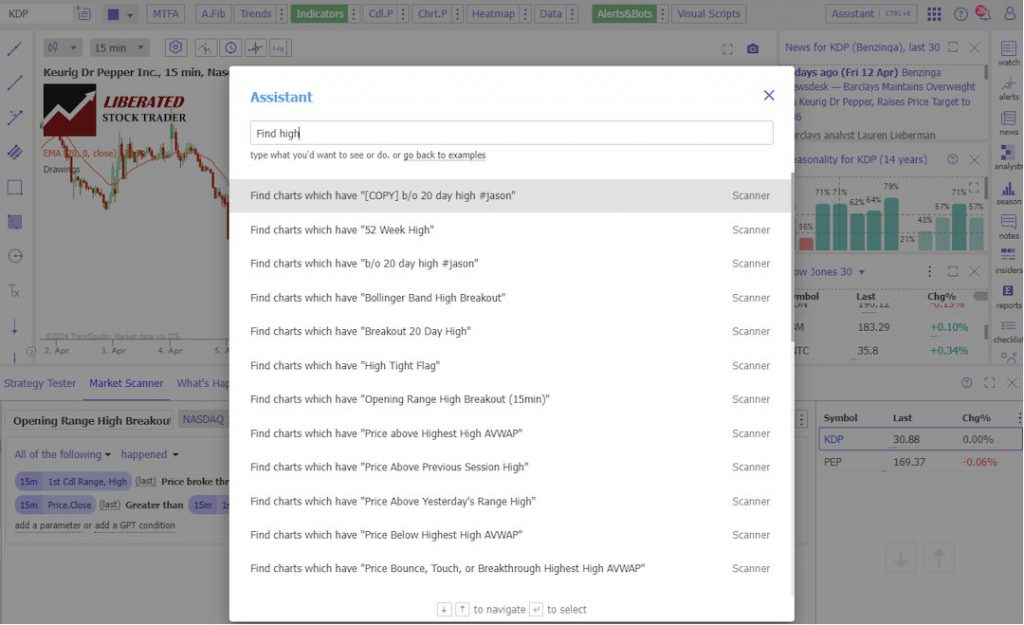
- Key Features:
- Automated Technical Analysis: Rapid identification of chart patterns and trading signals.
- Dynamic Price Alerts: Real-time alerts based on technical indicators.
- Backtesting Suite: Evaluate trading strategies with historical data.
- My Verdict:
- TrendSpider’s suite is comprehensive for traders who need a robust analysis and backtesting platform.
2. Trade Ideas for AI Trade Signals
Trade Ideas stands out when it comes to real-time data processing and accurate trading signal generation. The platform’s AI, named Holly, conducts market scans to generate high-probability trading signals.

The AI-powered signals can potentially provide valuable insights for making profitable trades.
- Key Features:
- AI-Powered Signals: Daily trade signals from Holly, the AI engine.
- Trading Bots: Capabilities to automate trading based on predefined strategies.
- My Verdict:
- Trade Ideas offers a solid solution for traders looking for up-to-the-minute signals and the option to leverage trading bots.
Overall, Trade Ideas offers a comprehensive suite of tools catering to experienced and beginner traders. Their AI technology sets them apart from other platforms, providing users with valuable trade signals and potential profit opportunities. With the
3. Tickeron for Human & AI Trading
Tickeron impresses with its AI-based predictions and trend analysis for various financial markets. I find its use of artificial intelligence to predict market moves particularly beneficial. This allows traders to make better decisions and potentially increase their profits.

In addition to its AI capabilities, Tickeron offers a wide range of technical analysis tools and real-time market data. This gives traders a wealth of information to help guide their trades and make strategic decisions.
- Key Features:
- AI Trend Predictions: Uses AI to forecast market trends.
- Pattern Search Engine: This allows me to find trading patterns easily.
- My Verdict:
- New and experienced investors may find Tickeron’s predictive capabilities and user-friendly interface a useful addition to their toolkit.
Overall, Tickeron is a great choice for advanced AI technology and comprehensive learning resources. Whether you are an experienced trader or a starting, Tickeron has something to offer everyone.
AI Video & Image Generation
In exploring AI tools for video and image generation, I’ve identified several key players that have profoundly impacted the creative landscape.
As a tech reviewer, I’ve had the pleasure of testing these tools. I’ll share my insights on how each stands out in its niche.
1. Pictory for Video Editing & Creation
My experience with Pictory has shown it to be a powerful tool for video editing and creation. I use Pictory to convert my YouTube videos into shorts and TikTok formats.
It uses AI to convert long-form content into engaging short videos, ideal for marketers and educators. It also offers advanced features such as auto-captioning, background music selection, and text overlay.
2. RenderForest for Video, Slides & Site Creation
I have been using RenderForest for over one year to create videos for my investing YouTube channel. It can create videos from scripts, but I find it particularly good for informational videos. Here is an example of a video I created using RenderForest.
RenderForest excels in video production, slideshows, logo production, and website creation, proving to be a versatile platform. Its user-friendly interface simplifies the creation of professional-looking media.
3. Klap for AI TikTok & Shorts Videos
For creators focused on trending platforms like TikTok, Klap offers innovative AI-powered video editing tailored to produce viral short videos with minimal effort.
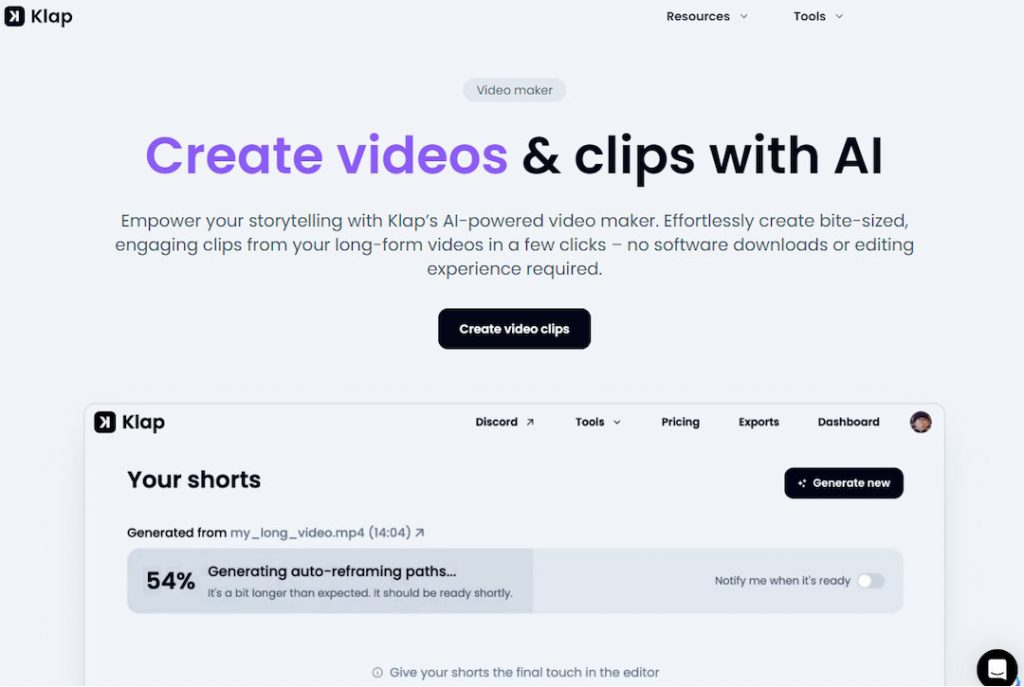
With its AI integration, Klap can suggest the best transitions, filters, and music for your videos based on current trends. This saves time and ensures that your content is up-to-date with what’s popular on social media.
4. Canva for Graphic Design & Social Media Posts
Canva is my go-to tool for graphic design, including creating eye-catching social media posts. I have been using Canva for over three years, and all my website thumbnails are created with It.
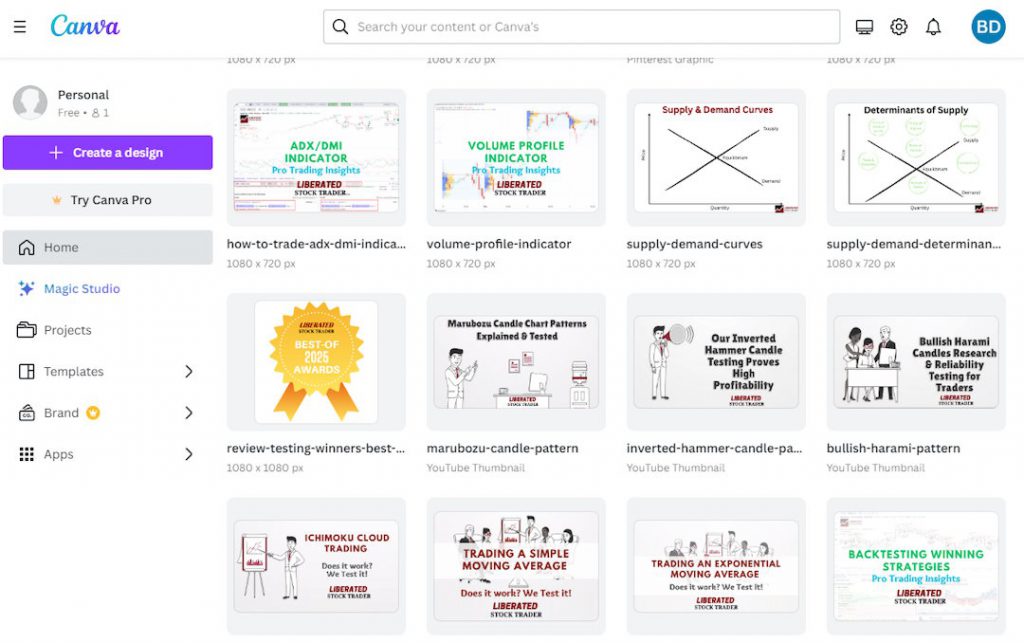
With its wide range of templates, fonts, and graphics, Canva allows users to easily customize their designs for various platforms such as Instagram, Facebook, and Twitter.
It also offers design elements specifically targeted towards businesses and marketers, making it a valuable resource for creating professional-looking content.
With the paid version, Canva enables an AI engine, so you can simply type what you want to have, and it will create it for you.
5. DALL-E for Generative Art
DALL-E is a revelation in generative art, capable of creating novel images from textual descriptions. The tool demonstrates the intersection of creativity and AI, pushing the boundaries of art and design. DALL-E is a paid upgrade with an Open-AI subscription, but it offers endless possibilities for artists and designers looking to experiment with new forms and styles.
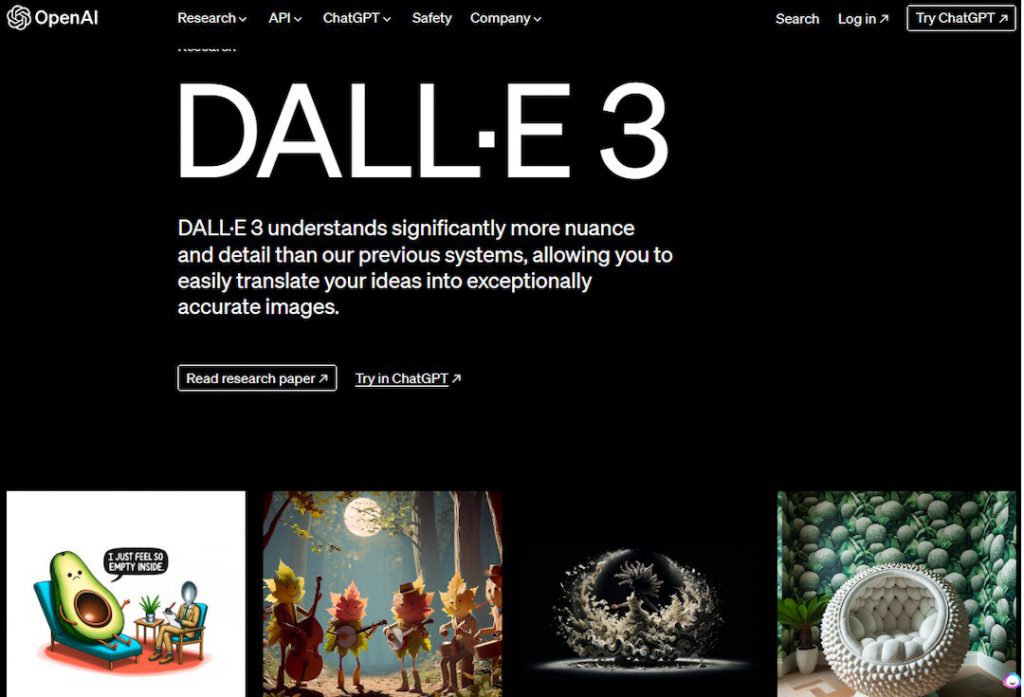
DALL-E takes in a text description of an image or concept and then uses its algorithms to generate a visual representation. Users can input specific details such as colors, shapes, and objects to create their desired image. This allows for endless possibilities and provides a space for creative experimentation.
6. Midjourney for Design Innovation
Midjourney is a design innovation powerhouse and a clear leader in image creation. For many, it is the gold standard. Its sophisticated algorithms and advanced technology make it a top choice for artists and designers looking to push the boundaries of their craft.
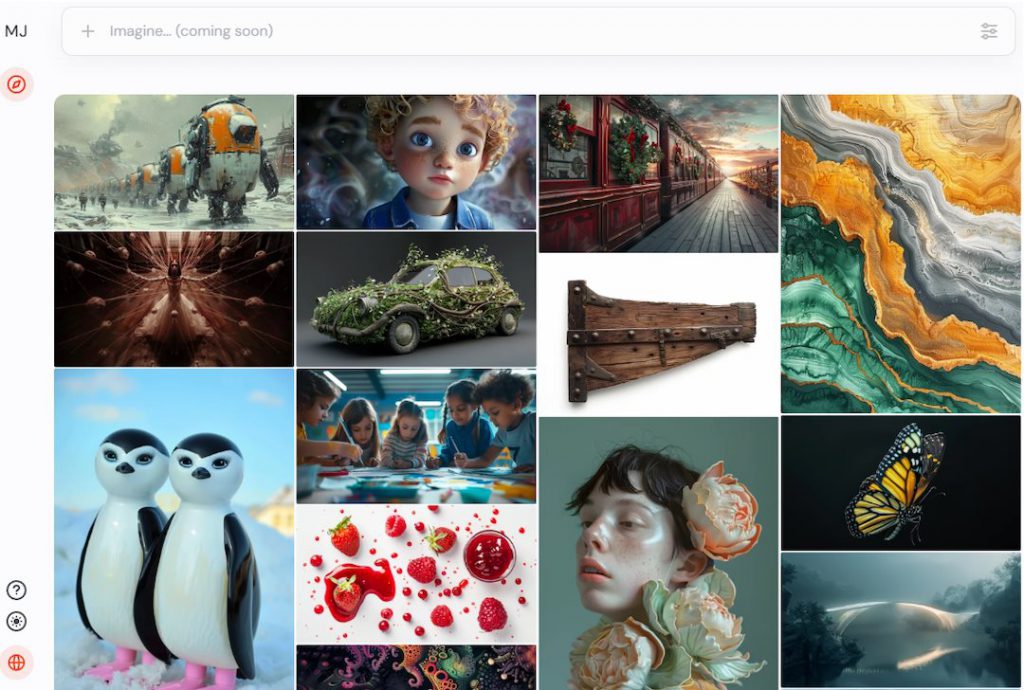
Midjourney is a serious upgrade from DALL-E, offering even more advanced features and a higher level of customization. Its powerful AI technology is constantly evolving, allowing for even more complex and realistic images to be generated.
But Midjourney isn’t just limited to image generation. It can also create entire scenes and environments, making it a valuable tool for video game designers, animators, and filmmakers.
With its intuitive interface and user-friendly design, Midjourney makes it easy for anyone to tap into their creativity and bring their ideas to life with stunning visuals. Whether you’re a professional designer or looking to explore your artistic side, Midjourney can take your imagination to new heights.
7. Runway for Generative Models
Having used Runway, I’m impressed by its robust suite of generative models, which cater to various creative applications, from video generation to image synthesis. Its user-friendly interface and seamless integration with popular design software make it a go-to tool for designers looking to incorporate AI technology into their workflow.
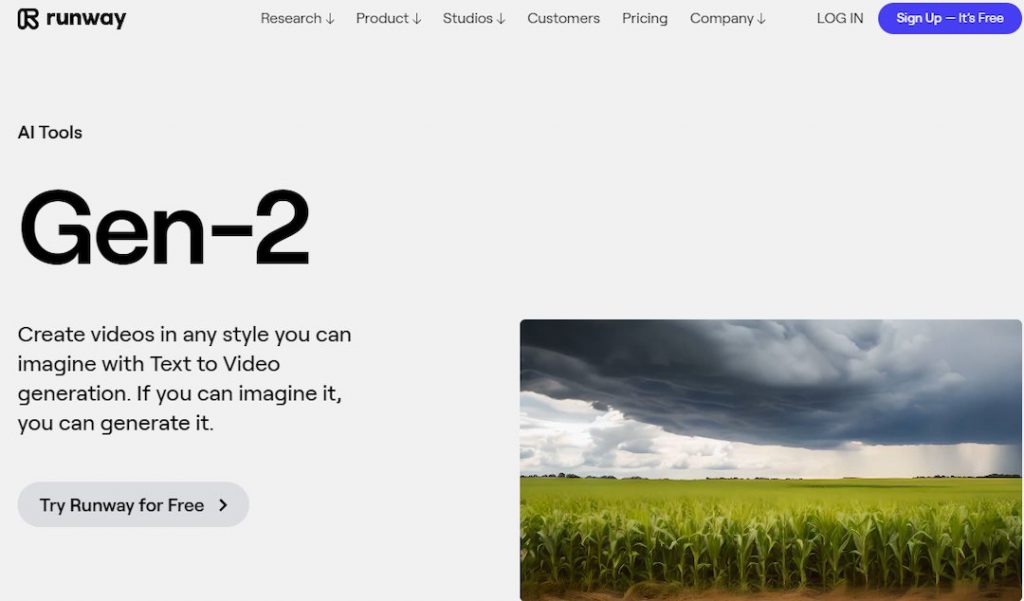
In addition, Runway provides a community platform where users can share their creations and collaborate with others. This fosters a sense of community among creatives and allows for further inspiration and learning from others’ work.
8. Stable Diffusion for Image Creation
Stable Diffusion is a game-changer in image generation. Its model generates high-quality images with remarkable speed, democratizing access to potent generative AI technology. With Stable Diffusion, users can create realistic images for a wide range of applications, from product design to conceptual art.
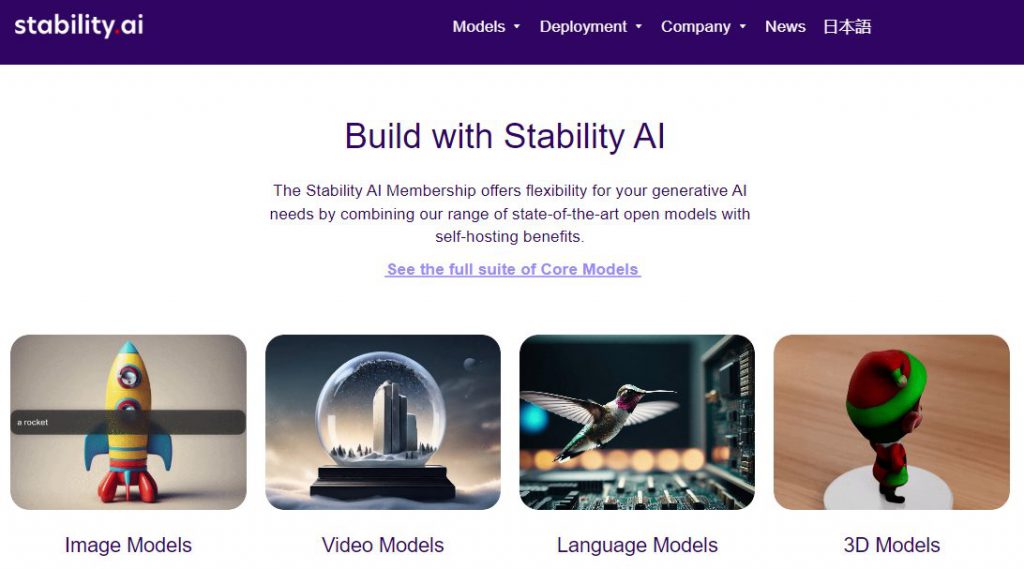
The process is simple: first, upload a photo or sketch of the desired image. Then, using the intuitive tools and settings provided, manipulate the image’s style and composition. The AI technology will then generate an image that fits your specifications while maintaining high quality and realism.
9. Descript for Transcription, Podcasts & Videos Editing
Lastly, my testing of Descript highlights its unique proposition: it combines transcription services with video editing functionalities. This is ideal for content creators looking to streamline their workflow for videos, podcasts, and shorts. With Descript, users can transcribe audio and video files, edit the text to change their content, and then export the edits to the original file.
Another benefit of using Descript for transcription is its ability to create a script from a recorded conversation. This is particularly useful for interview-based podcasts or documentaries where dialogue accuracy is crucial. Users can easily navigate the transcript and make necessary edits before exporting it as a script.
In addition to its transcription capabilities, Descript also offers advanced editing features such as adding music, sound effects, and transitions. Users can also collaborate with others on projects by sharing links for real-time editing and feedback.
AI Team Collaboration
In my experience, AI has significantly transformed how teams collaborate and manage projects. From tracking progress to optimizing workflows, AI-enhanced tools are pivotal in boosting team efficiency.
1. Asana for Project Tracking
Asana is a versatile project management tool indispensable for team collaboration. With its user-friendly interface and customizable features, it allows teams to track tasks, assign responsibilities, and set deadlines in one central platform.
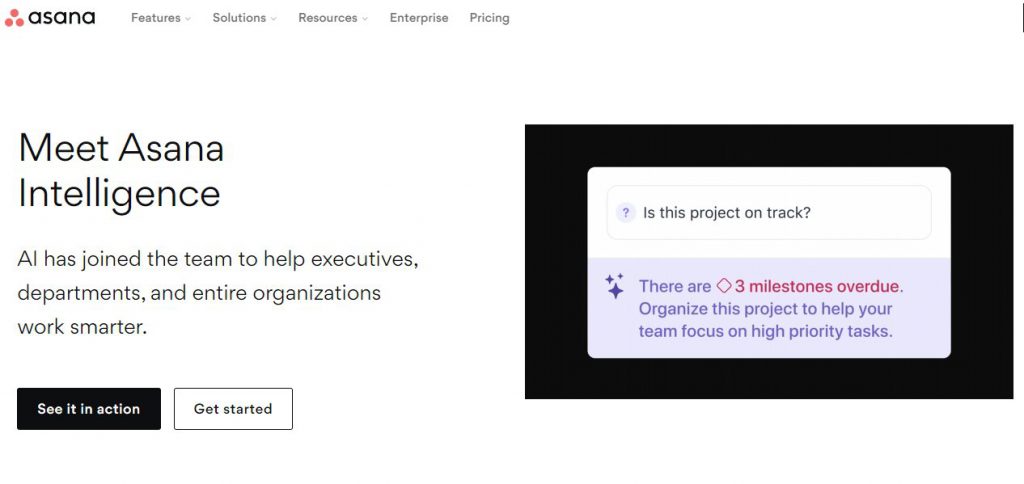
Its AI capabilities also help identify potential project roadblocks and offer suggestions for improvement.
Its AI capabilities enhance project tracking by:
- Predictive Prioritization: Suggesting tasks that should be tackled first based on deadlines and team capacity.
- Automated Reporting: Providing real-time project insights through customizable dashboards.
- Answering Real Questions: Asana AI allows you to ask questions about your projects and get instant answers.
Asana maximizes team productivity by providing a central project management and communication platform.
2. Trello AI for Team Workflow
Trello empowers teams with its AI-enhanced board and card system, streamlining workflow. By leveraging AI technology, Trello helps teams work smarter. Its intuitive interface and seamless integration with other tools make it a top choice for project management.
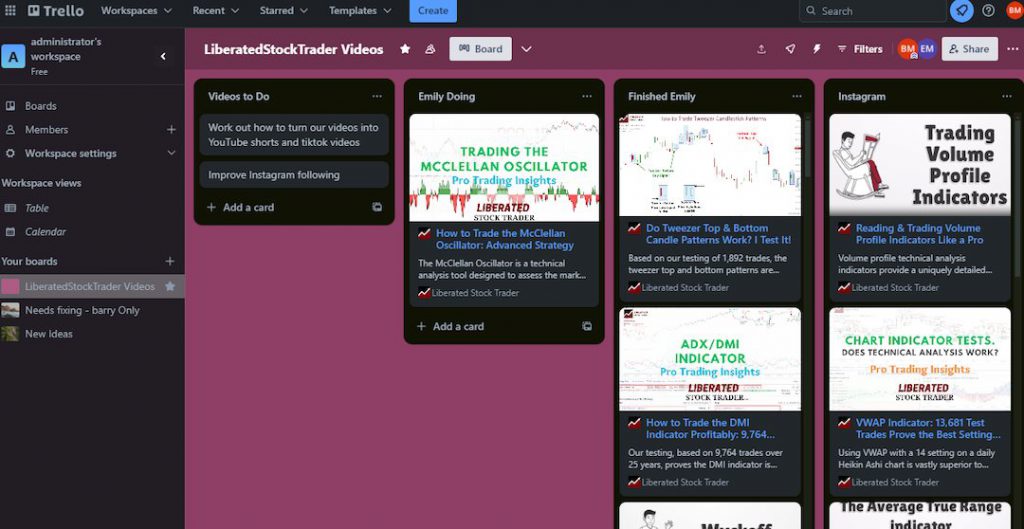
With AI, Trello offers:
- Smart Suggestions: Recommend labels, due dates, and checklists for better organization of projects.
- Visual Automation: Automating repetitive tasks to save time and effort.
- Team Insights: Analyzing team performance and providing actionable insights for improvement.
So whether you’re working on a complex project or managing a team’s workflow, utilizing AI tools like Asana and Trello can greatly enhance your productivity and success. Say goodbye to endless manual tasks and hello to efficient project management with the help of AI capabilities.
3. Slack for Teams
Slack offers a mix of communication, organization, and productivity features that make it an essential tool for teams. Its easy-to-use interface and integrations with other tools like Trello and Asana streamline communication and collaboration within a team.
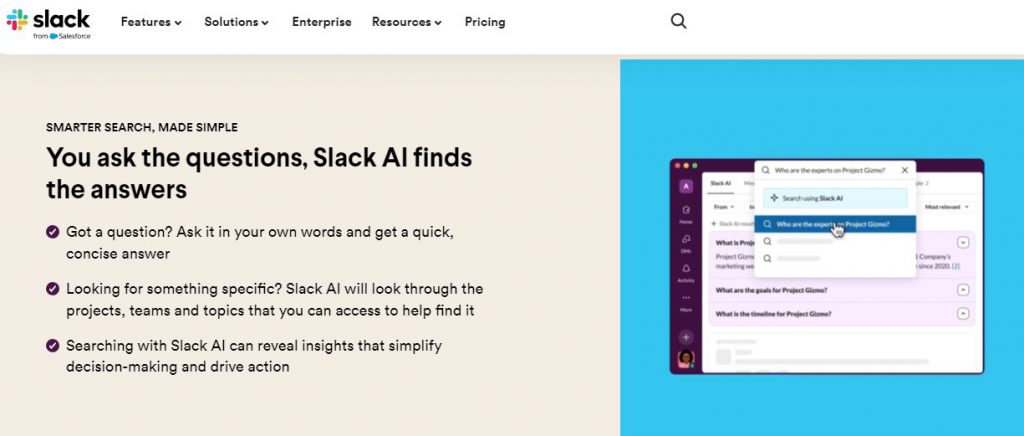
One of Slack’s standout features is its ability to create different channels for specific projects or topics. This lets team members stay updated on relevant discussions without getting lost in unrelated conversations. And with its search function, finding past conversations or files is a breeze.
However, its integration capabilities set Slack apart from other chat apps. Teams can seamlessly track tasks, deadlines, and progress within one platform by connecting it to project management tools like Trello and Asana. Slack’s robust integration with AI tools has revolutionized team communication:
- AI Bots: These bots assist in scheduling, feedback collection, and action item tracking directly within the chat interface.
- Workflow Automation: With AI, Slack’s workflows can be enhanced to streamline routine tasks without leaving the chat environment.
- Effective communication: Slack’s AI chatbot makes it easier for teams to stay connected and communicate efficiently.
4. Notion AI for Task Management
Notion uses AI to seamlessly manage tasks, making it a strong contender for enhancing team collaboration.
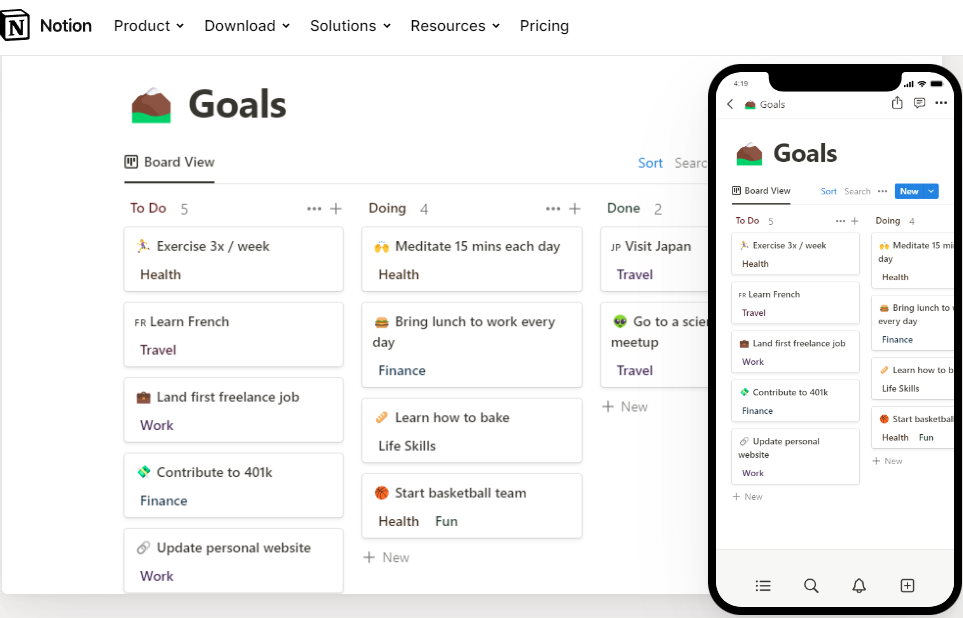
What makes Notio AI Different?
- Natural Language Processing (NLP): Notion’s AI utilizes NLP to understand and interpret natural language input from team members. Users can type tasks or deadlines using everyday language rather than specific commands or templates.
- Automatic Task Organization: Notion’s AI automatically organizes tasks based on priority, due dates, and assigned team members. This eliminates manual sorting and helps teams stay on top of their tasks without any added effort.
- Predictive Task Completion: With Notion’s AI, teams can accurately predict when a task will be completed based on past performance data. This allows for better time management and resource allocation within the team.
- Real-time Updates: With Notion’s AI, changes to tasks or deadlines are automatically updated in real-time across all devices. This ensures that teams have the most up-to-date information without delays or confusion.
- Personalized Task Dashboard: Each team member has their own personalized task dashboard where they can track their progress and manage their workload efficiently.
AI Task Automation
In my experience, automating routine tasks frees up valuable time and reduces the potential for human error.
1. Zapier for Workflow Automation
I utilize Zapier to create automated workflows, which they refer to as Zaps. Each Zap connects apps and automates tasks, turning what used to be time-consuming chores into seamless processes.
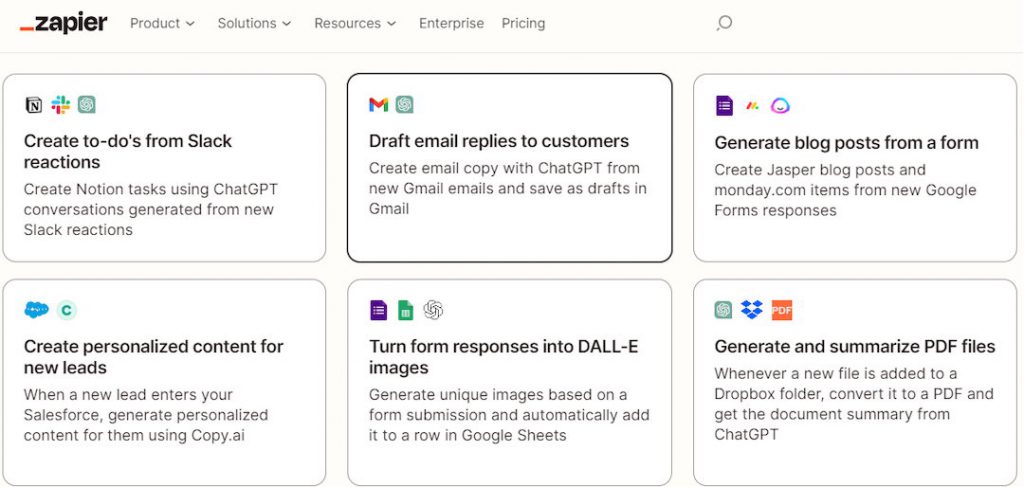
For instance, when I receive a form submission on my website, Zapier automatically adds the data to a Google Sheet and sends me a Slack notification. This level of automation saves hours each week.
- Key functions:
- Connect 3,000+ web apps
- Trigger actions upon certain events
- Automate cross-app workflows
2. Mem for Personal Note-Taking
I find Mem to be an innovative personal note-taking application that utilizes AI to revolutionize the way I organize my thoughts and ideas.
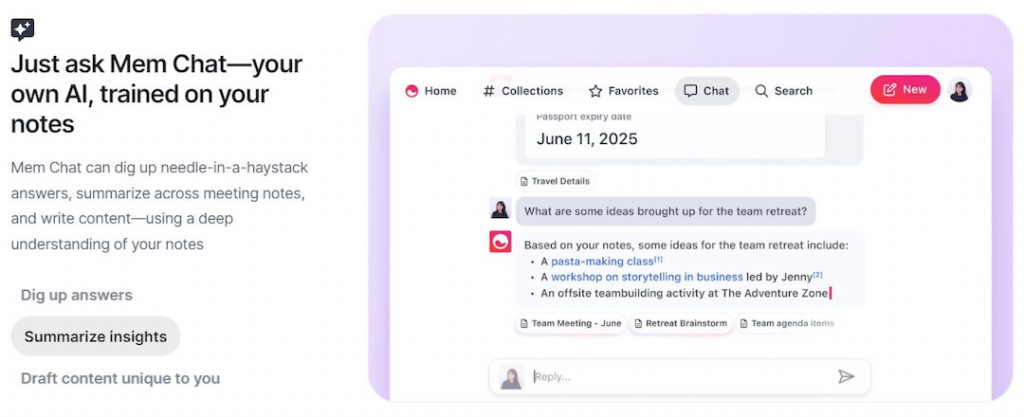
With its intuitive design, I can capture notes on the fly and rely on its intelligent suggestion feature to surface relevant information when I need it most.
- Key Features
- Quick capture: I can rapidly jot down thoughts or information.
- AI suggestions: It surfaces past notes relevant to my current work.
3. Tome for Crafting Presentations
When crafting presentations, Tome’s AI-driven approach powerfully assists me, enabling me to compile impactful slides easily.

What sets Tome apart is its ability to suggest design layouts and content, streamlining how I present my ideas.
- Key Features
- AI design suggestions: It recommends visual layouts that enhance my message.
- Content assistance: Helps me with wording and data integration.
4. Otter AI for Voice Recording
Otter AI is my go-to for transcribing meetings and interviews, making voice recording incredibly productive.
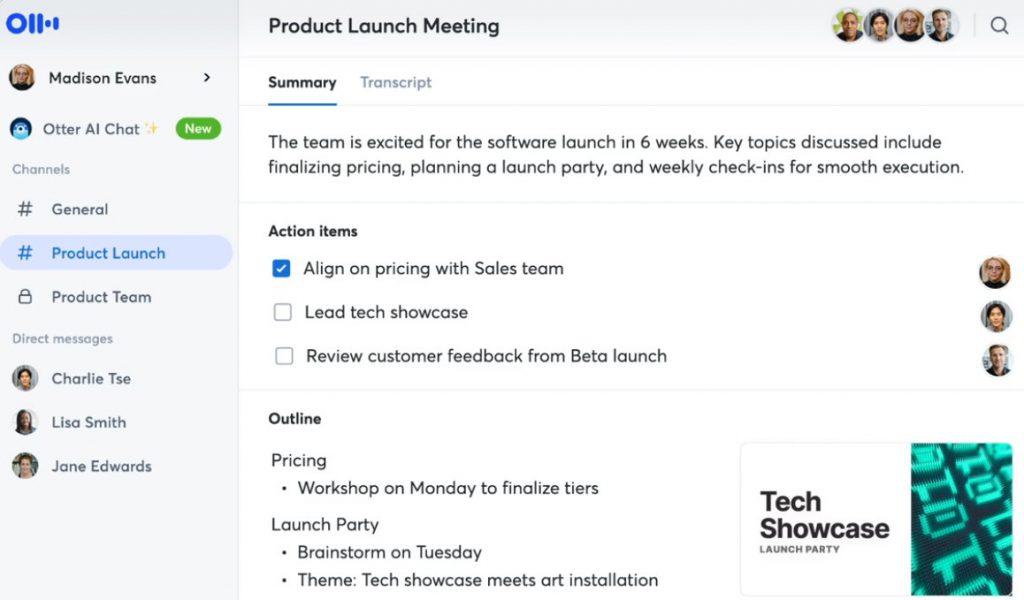
It turns my conversations into searchable, shareable notes that I can reference anytime, efficiently creating a record of my discussions.
-
-
- Key Features
- Accurate transcriptions: Translates verbal communication into precise text.
- Easy search: I can quickly find specific parts of my recordings.
- Key Features
-
ChatBots & Research
Chatbots have revolutionized user interaction by providing instantaneous, AI-driven responses. They are valuable across various sectors for their efficiency and convenience. Two standout platforms in this evolving space are ChatGPT and Character.ai. Each offers distinct advantages for users seeking to leverage AI for engagement and productivity.
1. ChatGPT for Leading Edge AI
ChatGPT, developed by OpenAI, is a robust tool that employs advanced natural language processing to understand and generate human-like text.
Its ability to dynamically learn and respond to prompts makes it an excellent choice for businesses and individuals.
I asked ChatGPT what it was good at, and here is its response.
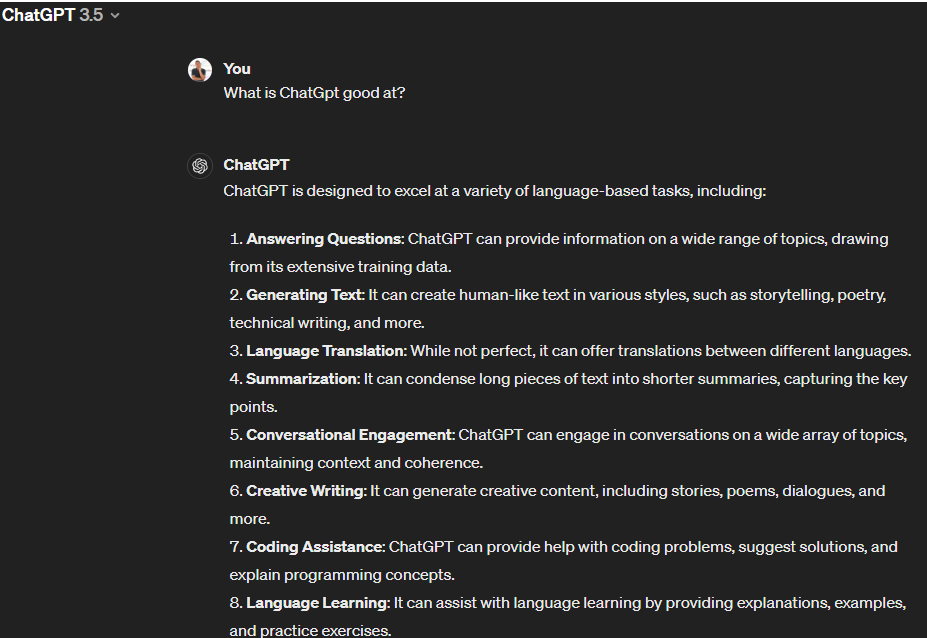
ChatGPT has seen numerous iterations, each introducing conversational abilities and improving context retention.
2. Character.ai for Personal AI Bot Creation
Character.ai is noteworthy for enabling users to create and interact with AI-powered characters. I appreciate its personalized approach, tailored to help users craft unique conversational agents.
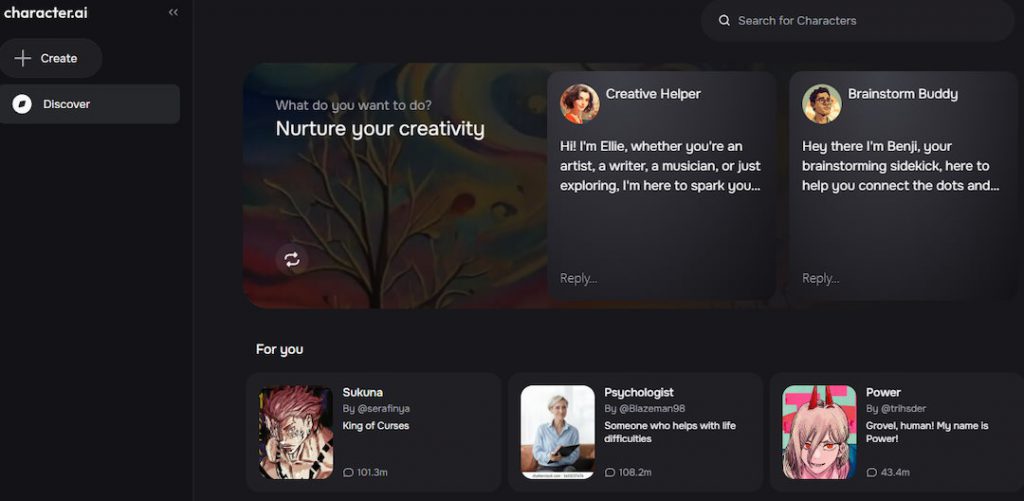
Notable aspects include:
- Customization: Users can design AI characters with specific personalities and knowledge areas.
- Interactivity: Provides a platform for interactive storytelling and entertainment purposes.
It is a novel platform for those interested in exploring the creative side of AI bot interactions.

